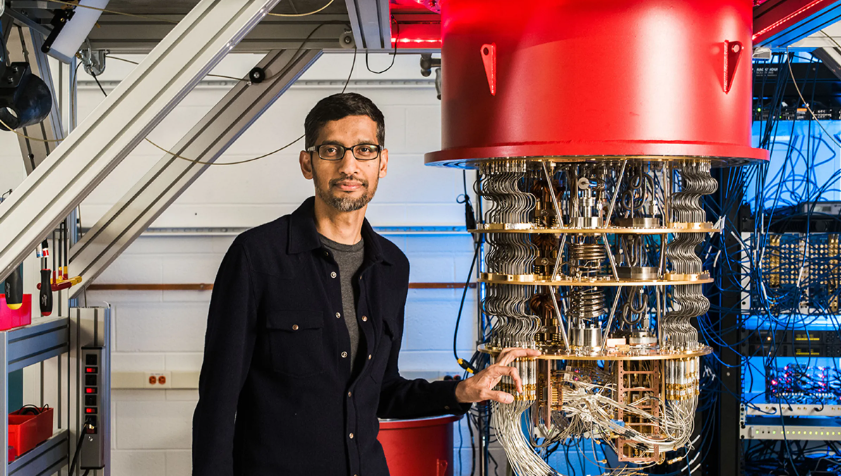"If you’re reading this, congratulations! You’re about to step into one of the strangest, most fascinating worlds science has to offer. Don’t worry; I’ll guide you through it. Just stay with me — and trust me, it’s worth it."
Today, we will not talk about a cricket match or a gardening initiative, although I promise this story is just as thrilling (and has a lot less dirt under your nails). This time, we’re diving into the mysterious world of quantum computing. Yes, I know — that might sound intimidating, like something out of a sci-fi movie. But what if I told you that quantum computing is real, it's here and it has the potential to reshape everything we know about technology, from medicine to AI to climate change?
I’ll be honest – when I first heard the words "quantum computing," I thought of some distant sci-fi universe. The term sounded cool, sure, but also intimidating. Quantum? Computing? Aren’t regular computers confusing enough? But the more I dug into it, the more I realized: this isn’t just for the Einsteins or the folks in lab coats. It’s a field that’s on the brink of changing our world in ways most of us can’t even imagine. And guess what? We’re all invited to the party.
You see, traditional computers are incredible. They’re like a well-trained orchestra, playing perfectly in sync, note by note. But a quantum computer? Well, that’s a bit like giving each musician their own time machine and letting them play in every possible combination at the same time. It’s bizarre, I know. But trust me, it’s also brilliant.
So, grab a cup of chai (or coffee, if you need it!), and let’s take this step-by-step. I’ll break it down, only this time, instead of batting averages, we’re talking bits and qubits. Ready?
Weird Wide World of "Both-And": Quantum Shenanigans
Let’s start with the basics. Most of the devices around us — our laptop, our smartphone, the machines running our Banks, Airlines, even the university’s systems — operate on a simple, yet powerful, system called “classical computing”, Yes, even that latest GPU of yours is already part of the classical era! In simple terms, classical computers think in bits, which are like little switches that can either be On (1) or Off (0) and every operation in a classical computer is a manipulation of these binary states. Classical computers process bits sequentially and deterministically, enabling them to solve a wide variety of problems by methodically working through calculations one at a time. It’s straightforward, and it works fantastically well for most tasks.
But here’s where things get interesting. Quantum computing doesn’t play by those rules. Instead of bits, it introduces an entirely new building block called the quantum bit, or qubit. And these qubits have a wild superpower called Superposition, which is the fancy way of saying they can be both 1 and 0 at the same time. This phenomenon, rooted in the principles of quantum mechanics, allows qubits to perform multiple calculations at once. Imagine flipping a coin—while it’s in the air, it’s neither heads nor tails but potentially both. This superposition of states is the foundation upon which quantum computing is built, enabling it to handle incredibly complex computations exponentially faster than classical computers.

To put it in familiar terms for Marvel fans — it’s like that scene in Avengers: Infinity War where Doctor Strange is scanning through 14 million possible futures to find the one where they win. A quantum computer does that kind of calculation naturally. It’s not bound to a single path; it can explore countless possibilities in parallel.
Now, if that isn’t mind-bending, I don’t know what is!
Since we’re already dipping our toes into the strange, let me introduce you to Schrodinger’s Cat. Don’t worry, no actual cats were harmed in this thought experiment. Imagine a cat in a box. According to quantum mechanics, until you look inside, the cat is both alive and dead simultaneously. Once you open the box, you “collapse” this strange state, and the cat becomes one or the other.

This idea of “both-and” — being in multiple states at once — is what gives quantum computing its power. Just like Doctor Strange’s multiverse of possibilities, quantum computers hold multiple states at once, processing layers upon layers of potential outcomes in one go. Hey, am I loosing you there, it's still Physics folks, just not the one we are used to. I know what you are thinking, as if the one we know isn't weird enough.
But here’s the thing: I’m not telling you this because I expect you to build a quantum computer yourself. I’m telling you because this technology is real, and it’s already starting to change the way we solve problems. And believe me, there are people out there doing some mind-blowing work in this field. I am not a geek or physicist, like you I’m just a curious mind, trying to grasp what all this quantum hype is about. And the deeper I go, the more I realize: if we don’t pay attention to quantum computing now, we might find ourselves playing catch-up in the very near future.
Quantum Pioneers
So, who’s actually behind this mind-bending science? Let me introduce you to a few figures who could inspire any of us, regardless of whether we understand qubits or not. Take John Preskill, a theoretical physicist from Caltech, who coined the term “quantum supremacy” — the moment when a quantum computer outperforms a classical one at a specific task. Preskill once described quantum computing as “controlled weirdness.” It’s not science fiction; it’s physics at its most profound.
Then, there’s David Deutsch, often considered the father of quantum computing. Deutsch envisioned a future where quantum machines could solve problems far beyond the reach of classical computers. He didn’t just see this as a scientific breakthrough; he saw it as a game-changer for humanity. His work has laid the foundation for everything we know about quantum computing today, that was way back in 1985 friends.
Then there’s Dr. Michelle Simmons, a quantum physicist and the Director of the Centre of Excellence for Quantum Computation and Communication Technology in Australia. She’s been pushing boundaries by developing a ‘quantum silicon chip’ — something that could one day make quantum computers as common as our current devices. She once said, “If we succeed, it will be the equivalent of splitting the atom.” Think about that — the impact of quantum computing could be as revolutionary as nuclear power!
These are the folks making this science real, turning “what ifs” into “what’s next.” They’re the ones building the technology that will let us simulate entire molecules in medicine, predict climate patterns with unprecedented accuracy, and even crack codes that are currently unbreakable.
One of the early pioneers of quantum theory was Richard Feynman. Feynman once said, “I think I can safely say that nobody understands quantum mechanics.” I don’t know about you, but that’s comforting to hear from a Nobel Prize-winning physicist. Feynman was known for his ability to make the most complex ideas accessible, and he was among the first to suggest that quantum physics could one day be used for computing.

These aren’t just “guys in a lab” – they’re visionaries who understood the potential impact of quantum computing on the real world. And thanks to them, this once-abstract field is starting to come into focus for the rest of us.
So, Why This Matters to Us?
Now, you might be wondering: “Sure, this all sounds interesting, but why should I care?” Here’s the thing. Quantum computing isn’t just a “cool” advancement; it has the potential to reshape industries. We’re talking about solving complex problems in fields like medicine, cryptography, climate science, and artificial intelligence.
Imagine being able to simulate entire molecules to create new drugs in weeks instead of years or optimize massive logistical networks in seconds. Picture a future where encryption is so secure that hackers stand no chance. Or think about understanding climate patterns with such precision that we could make accurate predictions years in advance. Quantum computing could make all this possible – and more. The power of quantum computing lies in its ability to solve specific problems exponentially faster than classical computers. Quantum computers won’t replace classical computers entirely but will serve as a complementary tool for solving problems that are currently intractable.

Universities are the breeding grounds for the next generation of innovators. If our researchers and students get a chance to explore quantum computing — even if only to understand its basics — they’ll be positioned at the forefront of a new technological wave. Imagine if we could lead the charge in producing quantum-literate graduates who could go on to make breakthroughs in healthcare, artificial intelligence, or climate science.
The global race to dominate the quantum industry is well underway. Governments worldwide are investing billions in quantum research, recognizing its potential to reshape national security, healthcare, and economic growth. Major corporations like Google, IBM, and Microsoft are already at the cutting edge of quantum technology, developing prototypes and testing algorithms with real-world applications.
One noteworthy example is the Google-NASA collaboration. Google’s quantum computer, Sycamore, has been working with NASA on simulations that could help identify new habitable planets across the universe. By leveraging quantum algorithms to analyze vast amounts of cosmic data, this collaboration aims to simulate planetary formation and atmospheric conditions, potentially identifying exoplanets capable of supporting life. The sheer computational power required for this task would be unfeasible on classical supercomputers, but quantum computing makes it possible, highlighting its transformative potential.

This is no longer science fiction; it's happening now, and the institutions that seize this opportunity will lead the next technological revolution.
The Quantum Revolution Begins With Us
Of course, there are challenges. Building a quantum computer isn’t like assembling a gaming PC. Quantum systems need extreme environments to operate — think temperatures close to absolute zero and shielding from even the slightest vibrations. Scientists call it “noise” (unwanted changes in qubit states) and it’s the equivalent of your computer having a meltdown because you sneezed too close to it.
But here’s the exciting part: every challenge is a call to action for the next wave of researchers, engineers, and problem-solvers. Whether it’s finding ways to stabilize qubits, developing error-correction algorithms, or just understanding how to make this tech more accessible, there’s room for talent across disciplines.
So, to anyone who’s thinking, “I’m not a physicist,” let me tell you: neither am I. Yet here we are, on the edge of something extraordinary, where our curiosity and willingness to learn can open doors to a world that once seemed impossible.
Fifteen years ago, people used to say, 'This is India, we don't buy clothes and shoes online. E-commerce can't sustain in our culture and market.' Well, we all know how that turned out. Quantum computing isn’t some distant dream. It’s already here, and it’s calling out to us — to understand it, to harness it, and to lead in this new frontier. So let’s not leave it to the physicists alone. Let’s make quantum computing a field that everyone can access and explore.
In the end, the future of computing won’t just be decided by scientists in labs; it will be shaped by everyone who’s curious, everyone who dares to ask, “What if?”
And who knows? Maybe someone reading this will be the next Richard Feynman or David Deutsch, pioneering quantum breakthroughs we haven’t even dreamed of yet.
Quantum computing isn’t just a technological upgrade; it’s a paradigm shift. It has the potential to redefine what’s possible in the realms of science, technology, and beyond. I won’t pretend to understand every nuance of it, but here’s what I do know: the future is arriving faster than we think, and quantum computing is at its forefront.



